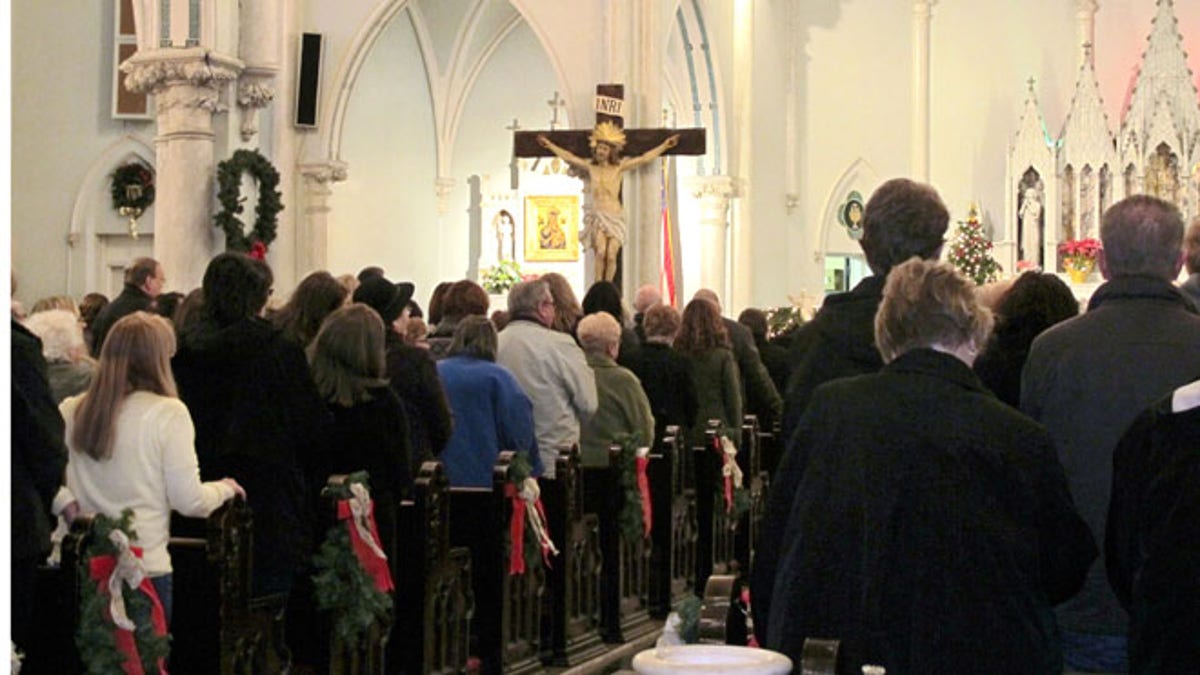
Jan. 12, 2014 : This photo shows people gathered for mass inside Our Lady of Perpetual Help Church in Buffalo, N.Y., during a Mass Mob. (AP)
BUFFALO, N.Y. – You've heard of flash mobs? Behold the Mass mob.
Playing off the idea of using social media to summon crowds for parties or mischief, mobs of Buffalo-area Roman Catholics have been filling pews and lifting spirits at some of the city's original, now often sparsely attended, churches.
It works this way: On a given Sunday, participants attend Mass en masse at a church they've picked in an online vote and promoted through Facebook and Twitter. Visitors experience the architecture, heritage and spirit of the aging houses of worship and the churches once again see the numbers they were built for, along with a helpful bump in donations when the collection baskets are passed.
"I call these churches faith enhancers. You can't help but walk in and feel closer to a higher power," said Christopher Byrd, who hatched the idea in Buffalo last fall and has organized two Mass mobs so far, both of which drew hundreds. He's heard from other cities about starting their own.
The aim, he said, is to reignite interest, support and perhaps even membership in older churches that "kind of fall off the radar screen of people."
One such church is Our Lady of Perpetual Help in a neighborhood settled by Irish immigrants along the Buffalo River. The church once brimmed with 800 families when it was dedicated in 1900. Today, fewer than 50 worshippers typically amble into the Gothic-style sanctuary for Sunday Mass.
It's a familiar story among city churches that were built for waves of Polish, German, Irish and Italian immigrants but whose congregations have dwindled with the city's population decline and suburban sprawl. Buffalo's population is less than half what it was in 1950, when it peaked at 580,000.
"We're still here," said the Rev. Donald Lutz, who welcomed a crowd of more than 300 on a recent Sunday after Our Lady of Perpetual Help, known to locals as "Pets," was selected for the Mass mob.
Organizers sought nominations from the public for churches on the Mass mob website and put the top three up for a vote. Online voting begins this week for the next mob, planned for March 23.
"It's wonderful," said Lutz, who learned his church had been chosen two weeks before. "It just shows that we are not just one parish, that it's the whole family of the diocese. We take care of each other.
"And," he added, "if it helps us pay a few more bills ..."
With every pew occupied, later-arriving worshippers stood against the back wall, reminding 88-year-old parishioner Elizabeth Barrett of the way it used to be in the church she has attended since birth, a block from her lifelong home.
"You had to get here very early when I was young, it was so crowded," she said. "And now there are just a handful. It's hard to accept, but you have to."
During the sign of peace, Lutz spent several minutes breezing up and down aisles, smiling and shaking hands. He invited all to a nearby community center for a pastry and coffee after the service.
Several visitors arrived at the church with cameras, aiming them at brilliant stained-glass windows imported from Austria, the church's pride and joy, and the ornate marble altar, the likes of which are seldom seen in the more modern suburban churches built today.
"It's wonderful to see the old churches. They're beautiful," said Barbara Mocarski, who came from nearby Lackawanna to be part of the mob. While the sanctuary is largely well-preserved, areas of cracking plaster and water stains show a need for costly maintenance.
"Seeing the community together and caring about them, I was really happy to hear about it," Mocarski said.
Karen Huber of the suburb of West Seneca hoped the Mass mob idea would bring more young people back to church so that crowds would again be the rule, not the exception.
The eight-county Diocese of Buffalo, in a restructuring, has closed nearly 100 churches in recent years as attendance and financial support has declined and priests have retired. Days after the Mass mob came an announcement that 10 suburban Catholic schools would close after this school year.
Byrd, 46, plans about six Buffalo Mass mobs a year. Chris Clemens and Luke Myer made the 90-minute trip from Rochester and are already promoting the idea in their city, where they blog about upstate New York's religious and spiritual history and sites.
Byrd, an activist in the Broadway-Fillmore neighborhood where he grew up, said there has been interest from other cities, too, and he hopes the flash mob social media hook will resonate with a younger generation for whom the pull of family tradition has relaxed.
Said Byrd, "They may think it's cool."

